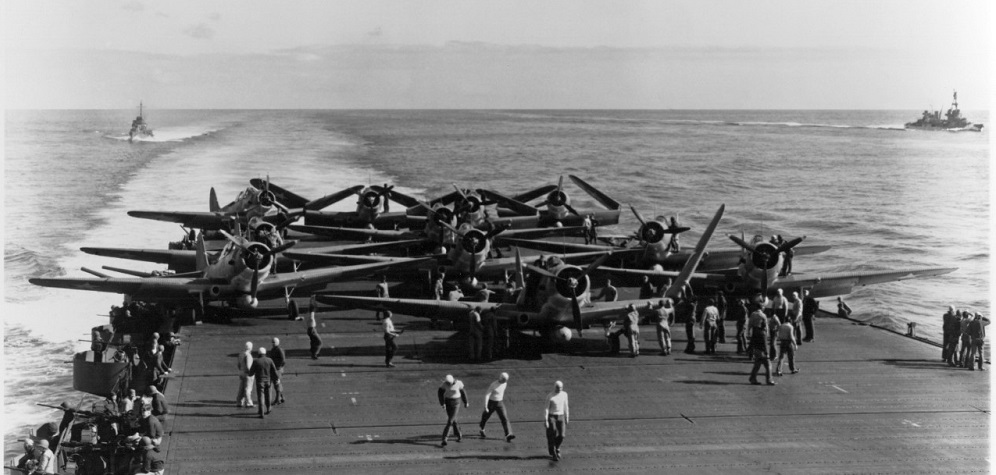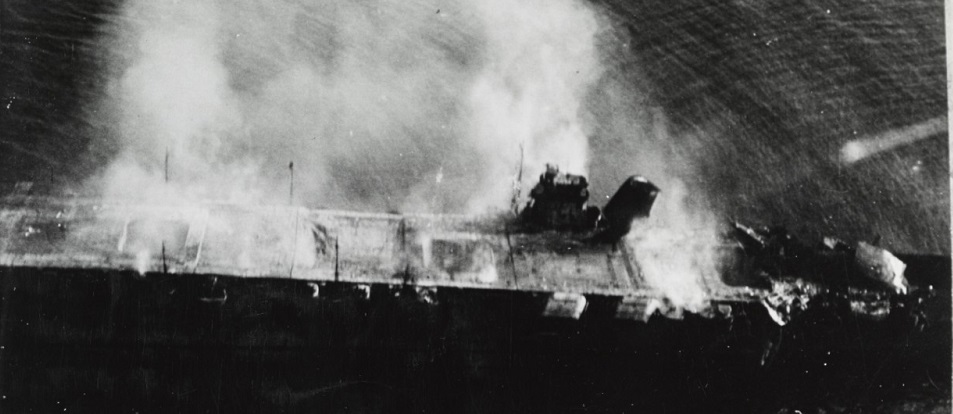
|
The Battle for Midway |  |
||||||||
|---|---|---|---|---|---|---|---|---|---|---|
 |
 |
 |
 |
 |
 |
 |
 |
 |
 |
 TBD-1 Devastators (VT-6) being prepared for launching on the USS Enterprise. | |||||||||
|
The Doolittle raid on Tokyo, which could have imperiled Emperor Hirohito, was a major embarrassment for the Japanese military. Vowing earlier that the Japanese mainland could never be bombed by American warplanes, Admiral Isoroku Yamamoto wanted to destroy completely, America's sea power in the Pacific. Following the Battle of the Coral Sea, he now focused on the island of Midway, which is just 1,300 miles west of Pearl Harbor. He assumed that the American fleet would steam to defend the island. All totaled, the Japanese fleet was far superior in numbers and he thought he could finally deal a final death blow to the American Pacific fleet. However, when final analysis is complete, the battle from the beginning actually favored the Americans if you consider that they already had 126 airplanes on Midway that could attack the Japanese fleet. And unlike an aircraft carrier, the island of Midway, could not be sunk.
Also in the works by Japan was another strike aimed at the Aleutian Islands, which stretch out into the Pacific from Alaska. The invasion of the Aleutians has historically been reported as a diversionary operation, but this was not the case. It was a major operation in its own right and developed by the Imperial Japanese Army to protect its northern flank from invasion from U.S. land-based bombers based in Alaska. What Yamamoto didn't know was that United States military intelligence officers had discovered the key to the Japanese secret code, and so the US knew of their plans. Yamamoto also thought the Yorktown had been sunk in the Coral Sea. Actually, she was badly damaged, but hard-working shipyard men in Pearl Harbor had accomplished the necessary repairs in 72 hours--a job that ordinarily would have taken more than two months. Yamamoto had assembled an imposing force. He sent six carriers, eleven battleships, sixteen cruisers and forty-five destroyers to converge on Midway. Against this giant fleet, Admiral Chester Nimitz had only three carriers--Yorktown, Hornet and Enterprise, nine cruisers and fifteen destroyers. Nimitz had also fortified Midway itself. At 5:34 a.m. on June 4th, a Navy Catalina flying boat spotted the Japanese attack force and radioed, "Many enemy planes heading for Midway." These were the carrier-based fighters and bombers, which were to "soften up" the island before the planned invasion. There were twenty-eight Marine fighter planes on Midway, under the command of Major Floyd B. Parks. Nineteen of these were old Brewster F2A "Buffalo" fighters. Immediately Major Parks took off with seven Buffalos and five Wildcats to intercept the enemy attacking force. The rest of the fighters were ordered up too, but held in reserve. When Parks first spotted the enemy formation at 14,000 feet, he saw over 100 fighter planes and bombers. The Zero escort was beneath the bombers, apparently not expecting fighter opposition. The Marine fighters peeled off and roared into the Vals, all guns blazing. Several of the Japanese bombers were hit, and dropped away toward the sea. But then the Zeros saw the Marine fighter planes, and climbed to meet the Wildcats and sluggish Buffalos. The Marine pilots didn't have a chance. The dancing Zeros cut up the brave defenders. Not only were the marines heavily outnumbered, but their planes, could not match the performance of the Japanese fighters. In a spectacular dogfight, the Americans lost plane after plane. In Parks' group, only two pilots lived. One of them was Captain Marion Carl. He destroyed one Zero on his first pass, but as he climbed for altitude again, other Zeros got on his tail. He nosed over, rammed everything to the firewall--that is, he gave his Wildcat full power and pulled away. A Wildcat could at least out-dive a Zero. In this way Captain Carl managed to escape. On his way home, he made another attack on three Zeros below him and sent one down, burning and out of control. The rest of the Marine fighter planes joined Major Parks' fight, but to no avail. After the "all clear," the Midway radio called, "Fighters land, refuel by divisions...." No fighters landed. Then came the call, "All fighters land and reservice." Only ten planes came back, and only two would ever fly again. It was the heaviest loss the Marines suffered in a single air battle, during the entire war. One of the US pilots said bitterly afterward that the Buffalo, "Should be in Miami, as a training plane." Later that same morning at 10:24 dive bombers from the Enterprise and Yorktown found the Japanese carriers refueling and rearming their aircraft. Most of the Devastator torpedo planes had almost all been destroyed by the Japanese fighter screen and the withering fire from the enemy carriers, but SBD dive bombers caught the enemy carriers off guard. The Dauntlesses nosed over and began their deadly attack. Within minutes, three enemy carriers were hit, and raging uncontrollable fires swept through the ships. |
 Aircraft carrier Hiryu burning a few hours before she sank. |
|
That afternoon, American fliers found a fourth large enemy carrier and badly damaged it too, but the US fleet now came under attack. Lieutenant Elbert McCuskey took off from the Yorktown with three other Wildcat pilots and faced the attacking Japanese bombers. The four American fighter planes disrupted the enemy formation, which was guarded by Zeros, and McCuskey personally shot down three of the bombers. Later that same day, he destroyed two Zeros escorting enemy torpedo planes. Both the Enterprise and the Yorktown were hit, however--the Yorktown so badly, that she could not be saved. Lieutenant McCuskey had been stationed on the Lexington when she went down in the Coral Sea. Now his second ship, the Yorktown, was doomed too. His one consolation was that he had blasted five of the enemy in one day. Yamamoto's Aleutian attack fared better. Japanese troops were landed at Attu and Kiska, far out on the string of islands, and it took nine months to dislodge them. But here too the United States had a bit of luck. A new-model Zero fighter plane crashed near Alaska, after an engine failure. Its pilot was killed accidentally as he tried to land. The US captured the Zero intact, and were able to study first-hand, its design and performance. As a result, the design of a new Navy fighter, the Grumman F6F Hellcat, was changed to compete with Zero. Soon, US Navy pilots would have a plane which could out-fly and outshoot anything, the enemy put into the air. |
 Japanese heavy cruiser Mikuma after being bombed by planes from USS Enterprise and USS Hornet. |
|
Midway was a turning point in the war in the Pacific. The Japanese fleet, burning and defeated, turned away. It would never again venture into open battle, that far from home waters and its stream of endless easy victories had finally ended. |
© The Aviation History On-Line Museum.
All rights reserved.
Created December 26, 2006.
Revised August 27, 2018.